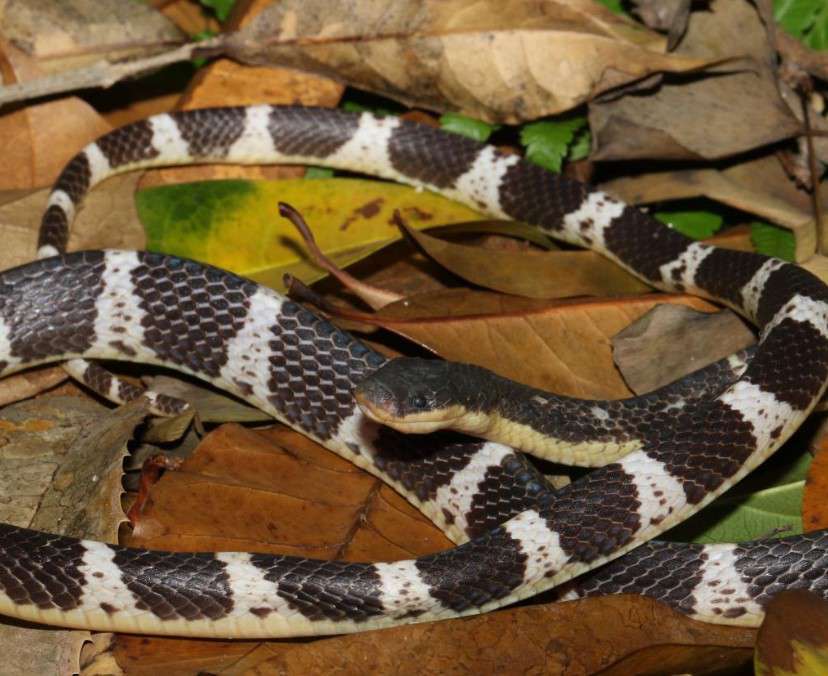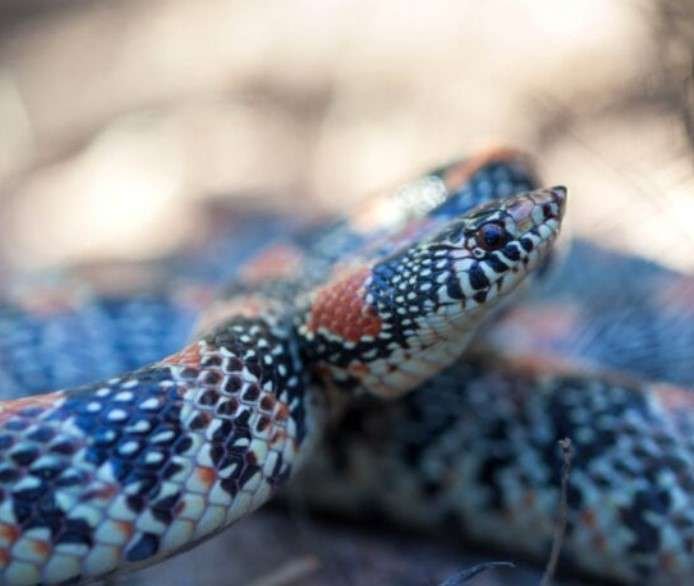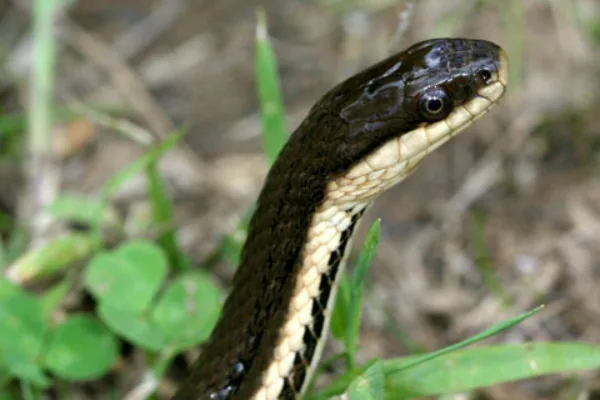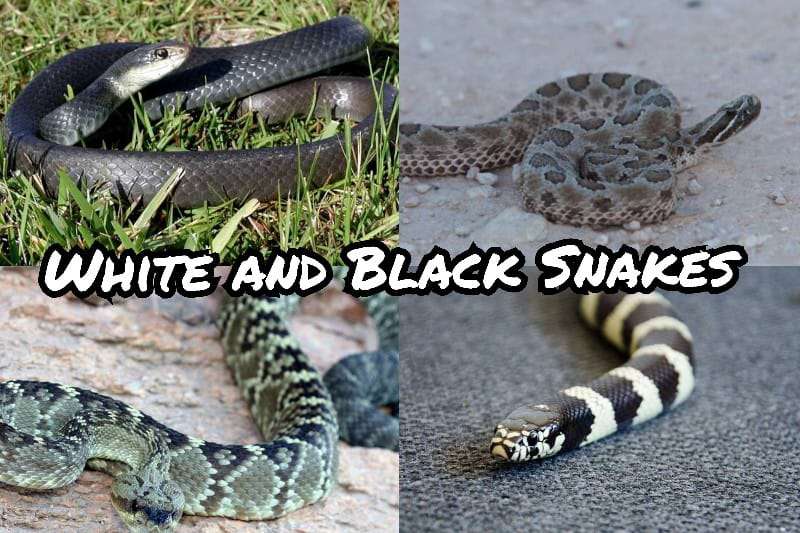We are back with another article, and this time we will cover a list of white and black snakes. Snakes having shiny white and black patterns are sometimes referred to as venomous, but the truth is only a few of them are dangerous to us.
Therefore, it is very important to have knowledge regarding eclectic snake species and how to differentiate between venomous and non-venomous snakes. But don’t worry; here in this list, we have tried to cover the venom status of the most. So, let’s begin.
List of White and Black Snakes
1. bandy-bandy (hoop snake)
The Bandy Bandy (aka "hoop snake"; V. annulata) arcs its body off the ground when it feels threatened #snakes #wildlifephotography #reptiles pic.twitter.com/9llYsWfQbG
— Donald McKnight (@donaldmcknight2) March 20, 2017
The first black and white snake in the list is the bandy-bandy also known as the hoop snake. These snakes have smooth-shiny black scales with horizontal white banded stripes from head to tail.
It doesn’t matter how beautiful these snakes are because they have potent venom and can be notoriously deadly to humans in large amounts. The bandy-bandy’s venom comprises neurotoxin that especially targets the nervous system.
There are six species of bandy-bandy all across Australia that we have mentioned in the last of the list. These snakes mainly feed on other snakes.
Scientific name: Vermicella annulata
Size: 50-60cm
Location: Australia
2. Black-tailed Rattlesnake
Another venomous snake on the list is Black-tailed Rattlesnake. These snakes contain hemotoxic venom that destroys red blood cells and stops blood clotting. But their venom is non-toxic to humans.
Compared to other rattlesnakes, they are less dangerous. Black-tailed Rattlesnakes are mostly in dusty-black color with white patterns all over them.
The female snakes are larger than males and can attain a maximum length of 125cm. Black-tailed Rattlesnakes primarily feed on rodents, birds, and other small animals.
Scientific name: Crotalus molossus
Size: 76-107cm
Location: the southwestern United States and Mexico
3. Suzhen’s Krait

Bungarus suzhenae, also known as Suzhen’s Krait, is a newly discovered snake. It was first identified in 2021 in the monsoon forest of southwestern China. Suzhen’s Krait is a species of venomous krait snake.
However, it is still yet to unveil how potent its venom is. The upper part of its body is completely shiny-black in color, and the lower part is yellowish-white with uniformly distributed white bands from the back of its head to tail.
Interesting Fact: Suzhen’s Krait feeds on eels like the Asian swamp eel and other small snakes like the yellow-spotted keelback water snake. But it doesn’t like to eat mice and frogs.
Scientific name: Bungarus suzhenae
Size: 1-1.5m
Location: southwestern China and northern Myanmar
4. Western Massasauga
Western Massasauga is a very dangerous and venomous pit viper that has a grey or tan dorsal background color with brownish-black patterns all over the body.
The venom of Western Massasauga is considered to be very potent compared to other rattlesnakes, but due to its capability of delivering a lower amount of venom in a single bite, its danger is reduced.
The venom contains harmful hemotoxin, which can cause severe pain and death of cells in tissues. It means the high dose of its venom is fatal to us.
Other common names of Western Massasauga are Ground rattlesnake, Gulf Coast massasauga, Edward’s massasauga, large ground rattlesnake, Say’s False Rattlesnake, Sonora ground rattlesnake, Texas massasauga, three-spotted shield rattler, triple-spotted rattlesnake. These snakes mainly feed on rodents, lizards, frogs, and other small animals.
Scientific name: Sistrurus catenatus tergeminus
Size: 35-91cm
Location: southwestern plains of the United States
5. Common Kingsnake
Common Kingsnake, also known as Eastern Kingsnake or chain kingsnake, is one of the most common non-venomous black and white snakes across the United States. These kingsnakes can grow up to 208.2cm. Common Kingsnakes are in shiny black color with narrow white stripes from head to tail.
Some of its common names are Black Kingsnake, North American Kingsnake, Pine Kingsnake, and many more. Like other kingsnakes, these snakes mainly feed on various small snakes, including venomous coral snakes and other rattlesnakes.
Scientific name: Lampropeltis getula
Size: 107-208.2cm
Location: The United States and Mexico
6. Butler’s Wolf Snake
Butler’s Wolf Snake is from the species of non-venomous wolf snakes and of the family Colubridae. These snakes are in shiny black color with beautiful narrow white stripes uniformly distributed all over the body from the back of the neck to the tail.
These snakes are oviparous, like most amphibians and reptiles. Butler’s Wolf Snakes mainly feed on rodents, geckos, lizards, and skinks.
Scientific name: Lycodon butleri
Size: 70-90cm
Location: the province of Krabi in southern Thailand and peninsular Malaysia
7. Common Garter Snake
Common Garter Snakes are mildly venomous snakes from the family Colubridae. Coming from the natricine snake species, the venom of the Common Garter is not dangerous to us and can cause minor itching and swelling, but it’s enough to take down small amphibians and other animals.
There are a total of 13 subspecies of Common Garter snakes, and only a few of them are in black and white colors. But here we are referring T. s. pickeringii, mainly found in Northwestern Washington, Vancouver Island, and southwestern British Columbia.
Scientific name: Thamnophis sirtalis
Size: 1.0-1.2m
Location: North America
8. Desert striped whipsnake
Another common non-venomous snake is Desert Striped Whipsnake. These snakes are indigenous to the western United States and can attain a maximum length of only 183cm.
Desert striped whipsnakes have a wide range of habitats, including the Rocky Mountains, flatlands, and forests. They have a dark brown or black color body with a yellowish to white belly.
Desert striped whipsnakes primarily feed on other small snakes, including venomous rattlesnakes, lizards, frogs, and rodents. These snakes are diurnal means they rely on their vision to chase down their prey.
Scientific name: Masticophis taeniatus
Size: 76-183cm
Location: the western United States and adjacent northern Mexico
9. Laotian Wolf Snake
Laotian wolf snake is a non-venomous snake of colubrid snake species that is native to Asiatic regions. It is a burrowing snake and shows nocturnal features.
It has a full black body with yellow and white crossbands on the dorsal and ventral sides, respectively. Having a size of at most 20 inches, Laotion wolf snakes are not aggressive and are reluctant to bite. They generally feed on small rodents, frogs, geckos, and lizards.
Scientific name: Lycodon laoensis
Size: 20 inches
Location: India, Thailand, Laos, Vietnam, Cambodia, China (Yunnan), West Malaysia, Northern Pakistan
10. California King Snake
The California kingsnake is a colubrid snake that is native to the western United States and northern Mexico. It is among the list of most popular pet snakes across the world due to its non-venomous nature and wide range of color patterns.
With a total size of 107cm, kingsnakes have a black or brown body with alternating dark and light bands on either side of it. During colder months, kingsnakes retreat underground and enter brumation (hibernation-like stage).
They generally feed on rodents, birds, and reptiles. They even hunt and eat venomous rattlesnakes as well. California kingsnakes are considered harmless to human beings.
Scientific name: Lampropeltis californiae
Size: 2.5-3.5 feet
Location: Oregon, California, Nevada, Utah, Arizona, southwestern Colorado, northwestern New Mexico, and northwestern Mexico
11. Malayan Krait (Blue Krait)
The Malayan Krait is a highly venomous species of snake of the family Elapidae. They have an average length of 108cm.
Its narrowed body has black and bluish alternating bands, which are separated by broad white bands on both sides of the body; it looks like a chessboard or checked pattern.
Malayan Krait feeds on other snakes but also eats frogs, birds, lizards, mice, etc. Its venom is highly dangerous, and 1mg of it only can annihilate or become a lethal dose for a 75kg human being.
Scientific name: Bungarus candidus
Size: 43 inches
Location: Southeast Asia from Indochina south to Java and Bali in Indonesia
12. Southern Black Racer
The southern black racer is a colubrid snake native to the Southeastern United States. These snakes are diurnal and eat rodents, frogs, toads, and lizards.
The southern black racer has a shiny jet-black body a white chin, and is a very fast runner; that’s why, they’re called ‘racer.’ Its scientific name has the word constrictor in it, meaning that they’re more likely to constrict their prey and suffocate it to death. Its greatest enemies include hawks and eagles.
Scientific name: Coluber constrictor priapus
Size: 72 inches
Location: Southeastern United States
13. Black Rat Snake
Black rat snake, also called western rat snake, pilot black snake, or black snake, is a non-venomous snake of species Colubridae that is native to North America. They are the largest snake that is found in Canada and officially the largest snake in North America.
Rat snakes can be adapted to a variety of regions, including bayou, prairie, and rock outcrops. Their characteristic feature includes tree climbing and spending most of their time on trees.
Rat snakes are excellent swimmers as well. They have glossy black bodies with brown patches on them. They hunt down small rodents like mice, rats, lizards, etc. During frightening situations, they release a foul kinking smell on their predators.
Scientific name: Pantherophis obsoletus
Size: 1-2.5m
Location: Mississippi River
14. Long-Nosed Desert Snake
 The long-nosed snake is a non-venomous snake of colubrid species native to North America. The long-nosed snake has a long upturned snout and, therefore, got its name. Its tricolor includes a combination of black, red, and yellow alternating crossbands on both sides of the body.
The long-nosed snake is a non-venomous snake of colubrid species native to North America. The long-nosed snake has a long upturned snout and, therefore, got its name. Its tricolor includes a combination of black, red, and yellow alternating crossbands on both sides of the body.
The long-nosed snakes are burrowing nocturnal snakes that feed on lizards, amphibians, and sometimes smaller snakes and infrequent rodents. Its habitat can be desert, grassland, shrubland, and savanna. They release a foul musk or blood if being harassed by their predators.
Scientific name: Rhinocheilus lecontei
Size: 41 inches
Location: Northern Mexico and into the southwestern United States
15. Malayan (White) Banded Wolf Snake

The Malayan Banded Wolf Snake, scientifically Lycodon subcinctus, is a non-venomous snake that resembles a Krait. But unlike Kraits, these snakes are harmless and not very aggressive.
Wolf Snakes do bite humans, but their bites result in minor pain and swelling. Malayan Banded Wolf Snakes have very beautiful slender bodies, black in color with white patterns. They primarily feed on geckos, skinks, frogs, and mice.
Scientific name: Lycodon subcinctus
Size: ~36 inches
Location: all countries of Southeast Asia, from mainland Myanmar in the northwest to the eastern islands of Indonesia
16. Queen Snake

The Queen Snake, scientifically known as Regina septemvittata, is a semiaquatic non-venomous snake with a black body and white linear patterns from head to tail.
“Other common names: banded water snake, brown queen snake, diamond-back water snake, leather snake, moon snake, North American seven-banded snake, olive water snake, pale snake, queen water snake, seven-striped water snake, striped water snake, three-striped water snake, willow snake, and yellow-bellied snake.”
These snakes are identical to garter snakes. Female queen snakes are slightly larger than males.
Scientific name: Regina septemvittata
Size: ~24 inches
Location: endemic to North America
17. Common krait
The common krait is a venomous snake found in the Indian subcontinent. Do you know it is one of the “Big Four” snake species responsible for a significant number of deaths by snakebites in Pakistan, India, and Bangladesh?
Talking about their length, these snakes typically measure around 0.9 meters in length on average, but they can grow as long as 1.75 meters. Do you know males tend to be longer than females?
Also, they have relatively longer tails than females. Moreover, the most astonishing feature of this species of snake is its striking black or bluish-black coloration.
Along with this, it features approximately 40 thin, white crossbars. When they get older, these markings may appear as a series of connected spots.
Scientific name: Bungarus caeruleus
Size: 90–175 cm
Location: India, Bangladesh, and Pakistan
18. Sind krait
The Sind krait is native to northwestern India, Afghanistan, and Pakistan. Do you know these snakes can reach a maximum length of 180 cm? Notably, when these snakes are young, they display white spots covering about one-third of their bodies.
Moreover, if you look at them closely and observe their appearance, you’ll notice that the Sind krait boasts an egg-shaped head with a short snout and relatively small eyes.
Also, their upper lips can be either yellow or white, adding to their unique appearance. Lastly, their tails come to a sharp, pointed tip, completing their distinctive features.
Scientific name: Bungarus sindanus
Size: approximately 100 cm
Location: northwestern India, Afghanistan, and Pakistan
19. Greater black krait
The Bungarus niger is commonly known as medium-sized, slender-bodied, and triangular in cross sections. Do you know this snake can reach lengths of up to 1.3 meters, although most adults average around 0.8 meters?
This snake is characterized by black eyes, a pinkish tongue, whitish upper and lower labials, an achin, and the anterior part of its venter. Also, its dorsal side is shiny black, while the interscales are whitish in color.
Moreover, the head of the Bungarus niger is flat and slightly separated from the neck, and its eyes are relatively small to medium-sized with round pupils. Also, its dorsal scales are smooth and glossy, featuring enlarged hexagonal vertebral row scales.
Scientific name: Bungarus niger
Size: 80-130 cm
Location: Northeast and North India, Nepal, Bhutan, and Bangladesh.
20. Burmese krait
Next on our list is the Burmese krait, which is also known as the spotted krait or splendid krait. This is a venomous snake species that can be found in Myanmar.
Do you know these snakes are of medium size, typically measuring around 1.1 meters in total length, with relatively short tapering tails that are approximately 150 millimeters long?
Also, they have flat heads that are slightly distinct from their necks, and their eyes are small to medium in size, featuring black round pupils.
Moreover, the scales on their dorsal side are smooth and glossy, with an enlarged and hexagonal vertebral row. Talking about their appearance, these snakes are triangular in cross-section.
And you can observe 11 to 14 broad white crossbars on their dorsum, each with spotted centers within the scales. Their belly is uniformly white in color.
Scientific name: Bungarus magnimaculatus
Size: around 110 cm
Location: China, India, Myanmar, Bangladesh
21. Red River Krait
Do you know the Red River krait, scientifically known as Bungarus slowinskii? This is a venomous snake that can be easily found in mainland Southeast Asia.
Do you know this snake is known for its striking appearance? It is characterized by alternating wide black and narrow white rings along its body and tail.
Additionally, it has dorsal scales arranged in 15 rows at its midbody, with the ones along the spine being enlarged and hexagonal in shape. Its subcaudal scales are also divided.
Scientific name: Bungarus slowinskii
Size: approximately 150 cm
Location: Vietnam, Thailand, Laos
22. Northeastern Hill Krait
The next one is Northeastern Hill Krait, which is scientifically referred to as Bungarus bungaroides. Also, this snake is a venomous elapid snake species found in the northeastern region. Do you know One of its defining features is the arrangement of the dorsal scales in 15 longitudinal rows?
Furthermore, its subcaudal scutes are divided towards the front, and it boasts a smooth, black back adorned with a series of narrow white to pale yellowish lines or crossbars.
Do you know The head of this snake is slightly set apart from the neck, and it sports a blunt snout? Talking about its body length, the largest male specimen can reach up to 140 cm in length.
Scientific name: Bungarus bungaroides
Size: approximately 140 cm
Location: Myanmar, India, Nepal, and Vietnam
23. Ceylon krait
Do you ever encounter a Ceylon krait, which is also known as a Sri Lankan krait? This snake is commonly found in Sri Lanka.
Most of this species of snake is observed, with an average length of 75 cm, but some individuals can grow as long as 90 cm. One of the interesting features of this snake is its elongated lung, which expands when it’s agitated.
Moreover, the venom of the Ceylon krait is particularly dangerous as it targets the central nervous system, potentially leading to death if the respiratory system becomes compromised.
So, it’s crucial to seek immediate treatment in the event of a bite to prevent fatalities within 12 hours.
Talking about its appearance, this snake boasts black skin adorned with slender white bands that run horizontally across its body.
Scientific name: Bungarus ceylonicus
Size: 75-90 cm
Location: Sri Lanka
24. Indian wolf snake
Next on our list is the Indian wolf snake, also referred to as the common wolf snake. It received the scientific name Lycodon aulicus.
This beautiful black and white snake is a harmless snake usually seen in the landscape of South Asia and Southeast Asia. Do you know this snake is identifiable because of its small, slender body, smooth scales, and white belly?
The snakes are mostly grayish-brown, with some black individuals. Considering its appearance, you can also observe that this snake has thick bands, usually white, and a flattened head broader than the neck.
Scientific name: Lycodon aulicus
Size: approximately 71 cm
Location: Pakistan, Sri Lanka, India, Myanmar, Bangladesh, and Nepal
25. Many banded kraits
Meet the many-banded krait, a fascinating venomous snake known by different names like the Taiwanese krait or Chinese krait. You can easily see these snakes in central and southern China and Southeast Asia.
In terms of its length, you can find this snake ranging from medium to large in size. But if you want to know what the average length is, then this snake can grow 100–130 cm.
Furthermore, do you know this snake has a slender body and is moderately compressed, with smooth scales and a distinct vertebral ridge?
Also, its color is black to dark bluish-black, with 21–30 white cross bands along its upper body. The snake’s head is primarily black, and its eyes are small and black.
Scientific name: Bungarus multicinctus
Size: 100–130 cm
Location: China and southeastern Asia.
26. Ruhstrat’s wolf snake
Let’s talk about Lycodon ruhstrati, a fascinating snake known by several names, such as Ruhstrat’s wolf snake, mountain wolf snake, and Formosa wolf snake. Do you know you can find this non-venomous snake in various regions, including Taiwan, southern and eastern China, and northern Vietnam?
But you might be wondering What makes this snake particularly interesting? that is its diverse color patterns.
These snakes can have black or dark-colored backs with white or light-colored crossbands. Do you know they can grow to a substantial size that is 94 centimeters in length?
Scientific name: Lycodon ruhstrati
Size: around 94 cm
Location: Taiwan, southern and eastern China, and northern Vietnam
Other List:
-
27. Puget Sound Gartersnake
-
28. Northern pine snake
-
29. Speckled Kingsnake (having yellow and white patterns)
-
30. Western Terrestrial Garter Snake
-
31. Weipa bandy-bandy*
-
32. Worm-like bandy-bandy*
-
33. Pilbara bandy-bandy*
-
34.Northern bandy-bandy*
-
35. Wide-banded northern bandy-bandy*
-
36. Eastern bandy-bandy*
-
37. Malayan Bridle Snake (usually brown and white or brown)
-
38. White-banded wolf snake
-
39. Eastern Rat Snake
-
40. European Grass Snake
(*) denotes venomous.
Now, it’s time to conclude the article on “Snakes that are black and white.” We have only explained 14 of them that are uncommon. Indeed, some of them are venomous, but the most dangerous is Western Massasauga. So, it’s better to always identify the snake before reaching them.
FAQs:
Q1: Are all black and white snakes venomous?
Ans: No, while many are non-venomous, some like the bandy-bandy and Western Massasauga are venomous. Identification of the species is crucial for determining venom status.
Q2: What is the significance of the white bands on the bandy-bandy snake?
Ans: The white bands on the bandy-bandy snake serve as distinctive patterns used for camouflage and potentially species recognition.
Q3: Are Black-tailed Rattlesnakes dangerous to humans?
Ans: Black-tailed Rattlesnakes possess hemotoxic venom, but their bites are generally not lethal to humans. Seeking medical attention is advisable for any snakebite.
Q4: Tell me more about Suzhen’s Krait’s feeding habits.
Ans: Suzhen’s Krait has a unique diet, feeding on eels and small snakes, avoiding mice and frogs, setting it apart from other snake species.
Q5: What is the danger level of the Western Massasauga’s venom?
Ans: Western Massasauga has potent venom, but its danger is reduced as it delivers a lower amount of venom in a single bite compared to other rattlesnakes.
Q6: How can I differentiate between a venomous and non-venomous snake like the Common Kingsnake?
Ans: Common Kingsnakes are non-venomous and can be identified by their shiny black color with narrow white stripes. Specific knowledge of snake species is essential for accurate identification.
Q7: What are some common names for Western Massasauga?
Ans: Western Massasauga is known by various names, including Ground rattlesnake, Gulf Coast massasauga, and Texas massasauga, among others.
Q8: Tell me more about Laotian Wolf Snake’s habits and habitat.
Ans: Laotian Wolf Snakes are non-venomous, mainly feeding on rodents, geckos, lizards, and skinks. They are found in southern Thailand and peninsular Malaysia.
Q9: Are Common Garter Snakes dangerous to humans?
Ans: Common Garter Snakes are mildly venomous, causing minor itching and swelling. Their venom is not dangerous to humans but effective against small prey.
Q10: What is the habitat of Desert Striped Whipsnake?
Ans: Desert Striped Whipsnakes are found in the western United States, including the Rocky Mountains, flatlands, and forests.
Q11: Can Malayan Krait’s venom be fatal to humans?
Ans: Yes, Malayan Krait’s venom is highly dangerous, and even a small amount can be lethal to humans. Immediate medical attention is crucial in case of a bite.
Q12: What distinguishes the Southern Black Racer from other snakes?
Ans: Southern Black Racers are diurnal, fast runners, and constrict their prey. They have a shiny jet-black body with a white chin.
Also Read:

As a content writer, I like to write about different niches. I have a curiosity about nature and animals. And like to learn about them. Through my writing, I like to share my experience and knowledge with you. I hope you are enjoying it too.
